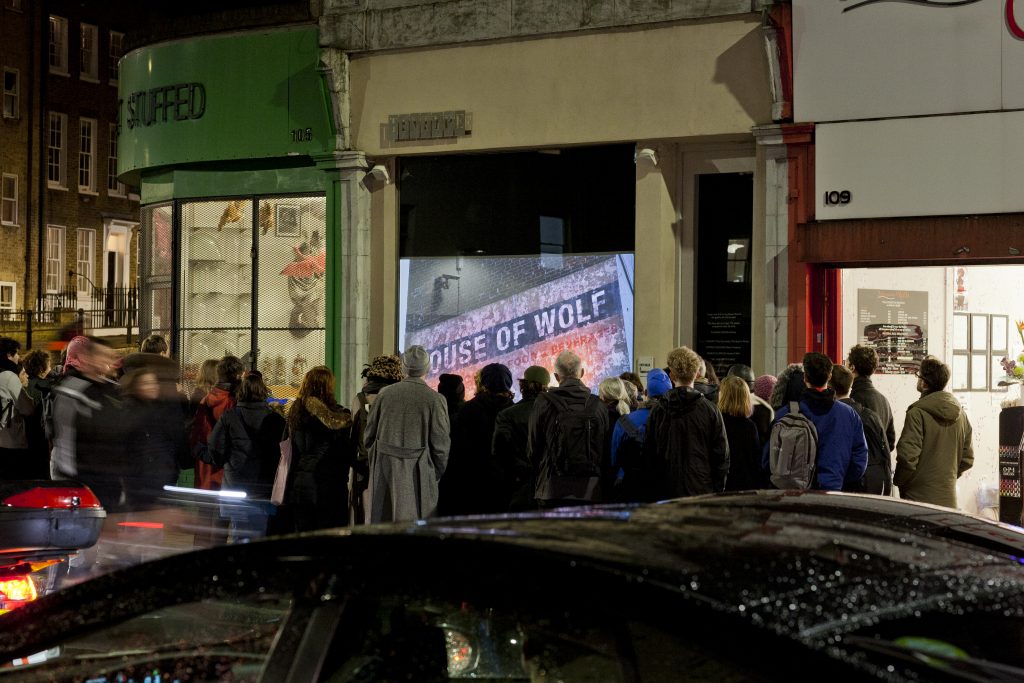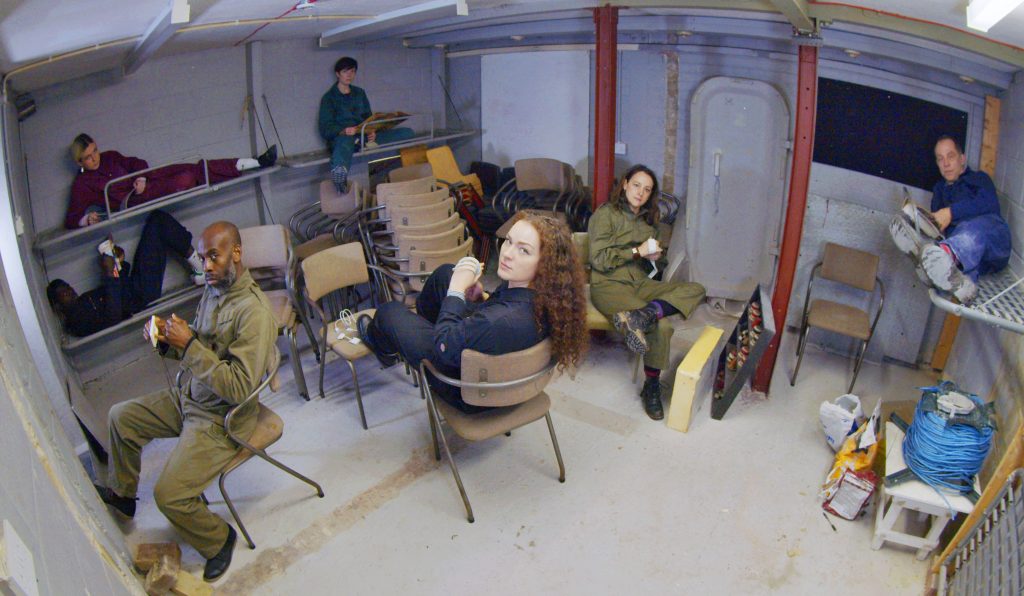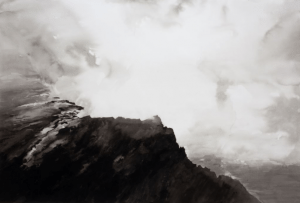
Essex Road-6. Photo by Cameron Leadbetter
For ESSEX ROAD 6, Tintype gallery’s front window has once again transformed into a public screen for five weeks with eight short films back-projected on a loop every evening into the gallery’s window, visible from the street as a form of public art. The annual Essex Road commission is recognised for its significance within the moving image arts in the UK, enabling eight artists each year to create new work. Since its inception six years ago, Tintype has commissioned 48 artists’ films, including works by Benedict Drew, Melanie Manchot John Smith, and Maryam Mohajer, who represents the decision to introduce an animation strand to this year’s programme. Her short film, Grandfather Was a Romantic was just awarded a BAFTA award for best short animation last night.
The artists are given a brief to create a short film that responds creatively to the street that Tintype gallery is located on. Starting in Islington and running north all the way up to Balls Pond Road on the cusp of Dalston, Essex Road has historically been somewhat like Upper Street’s scruffier sibling: home to a variety of independent pubs and businesses, including a taxidermy shop and one of London’s oldest fishmongers.
I caught up with Director Teresa Grimes to discuss the artists, her selection process and the importance of curating a diverse selection of content. She explains: “It’s always been important to curate a lively, diverse, and adventurous combination of work. If all of the films were stylistically and conceptually similar [the programme] would be coherent, but dull. I tend to go for a mixture of styles and approaches instead. It’s a fairly instinctive process, like gradually fitting a jigsaw together.”
I asked Teresa to shed some light about the artists behind my four favourite films from the programme:
Ayo Akingbade’s Hella Trees: “I had seen Ayo give a talk at Peer and knew she’d bring a younger, fresh, highly individual perspective”. Hella Trees was filmed in nearby Colebrooke Row and Duncan Terrace Gardens, and follows an artist whose practice is obsessively rooted in trees and their unique appearance, inviting us to look closer and comparing their individuality to that of humans.

Tintype Essex Road 6 AYO AKINGBADE Hella Trees
Adam Chodzko’s film Fluid Dynamics; The Quail is Rising is the result of connecting a rich seam of local histories combined with a chance conversation on the street while he was on a recce. Teresa explained that, “this then led him to a strange Sea Scouts building that is a replica of a ship. He connected this discovery to the New River , the remains of a 17th century project to bring fresh water to London which runs under the road very close to here. The Sea Scouts ‘ship’ is also the name of a destroyer that locals in Islington adopted during the Second World War.”

Tintype Essex Road ADAM CHODZKO Fluid Dynamics. The Raising of the Quail 3
Patrick Goddard brings a self-satirical and politically loaded take on the role of the valuation of properties in Essex Road and the surrounding area. Impersonating an inheritor of the Tintype gallery, in his film Black Valuation he has the building valued by an unsuspecting property agent. The exchange is covertly recorded on the gallery’s CCTV cameras, as Patrick dons full-on corpse paint (supposedly part of a Halloween costume) and reveals in his conversation with the agent that he plans to evict Teresa and convert the property into flats.

Tintype Essex Road 6 Patrick_Goddard_
Melanie Smith’s film 5 MINS is another example that was all shot in the immediate vicinity, at the nearest bus stop to the gallery. “Because Mel is such a brilliant artist, the film is a like a Len Lye film: a choreographed dance with dots, numbers and letters [that] builds to a crescendo suggesting the multifarious confluence of lives in a big city and the arbitrary, often sinister, surveillance that surrounds us” Teresa says of the film. Melanie’s work had initially deeply impressed Teresa at the 2018 Liverpool Biennial.

Tintype Essex Road 6 MELANIE SMITH 5 MINS 13.
Originally hailing from a film background, Teresa has previously likened running a gallery to producing a film and it is clear that this outlook has affected the Essex Road commissions: “Running a gallery combines practical and conceptual skills, and involves collaborating with people, so it is similar to how producers in film and TV need to operate. While the Essex Road project is no different from putting on an exhibition, because it involves commissioning eight artists to make short films inevitably my role [as] director of Tintype segues into executive producing” she explains.

Tintype_Essex_Road_6 _WEBB-ELLIS, For One Who is Exhausted, HD video still, 2020 © the artists, Courtesy of Tintype
“Looking back on it, I wish I had been more of a hands-on producer for many of the films. I think that more [of my] input from could have been helpful, at both the ideas and editing stage. Not that I’m [a] great creative genius, but it is good to have ideas scrutinised and challenged. People who work in film and television get used to that, but artists are perhaps less used to it [at the making stage]. I was sometimes too tentative at putting across my own thoughts and critical ideas.”
The benefits of public art are widely discussed in the context of public understanding of art and social cohesion, but the Essex Road commission further underlines the role of art galleries in creating an archive of the local area. Teresa upholds the choice of a James Joyce quote in the project’s press release, “in the particular is contained the universal” to illustrate the idea that you can value your own neighbourhood but also be taken beyond it: “At the opening one person was watching Lucy Harris’s film shot in South Library – and she had no idea that the library itself was about 20 metres away from Tintype.”
The stories told in these films have now evolved from 48 artworks that were shown on the street to existing forever within the public realm, so the Essex Road programme is leaving behind an important legacy and forming a unique archive. “We’ve also done some work with local schools – in fact we are going to take over the screenings next week for half an hour to show a short animation that a local primary school made with our help.”

Tintype_Essex_Road_6_Maryam_Mohajer, NI, HD video still, 2020 © the artist, Courtesy of Tintype
ESSEX ROAD 6 runs at Tintype Gallery until February 9 2020









